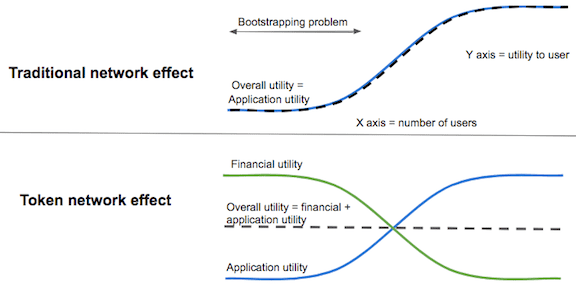The killer app of the internet is networks. The web and email are networks. Social apps like Instagram and Twitter are networks. Marketplaces like Uber and Airbnb are networks.Networks get more valuable with more participants, which is great when they are at scale, but cuts the other way when starting out. This is the bootstrapping problem.In the Web2 era, overcoming the bootstrapping problem meant heroic entrepreneurial efforts, plus in many cases spending lots of money on sales and marketing. Because bootstrapping networks is so hard, it’s likely that there are many networks that should exist — that would improve our collective well-being — but don’t because no one has figured out how to bootstrap them.Web3 introduces a powerful new tool for bootstrapping networks: token incentives.The basic idea is: Early on during the bootstrapping phase when network effects haven’t kicked in, provide users with financial utility via token rewards to make up for the lack of native utility.

(This chart comes from a longer blog post I wrote on the topic back in 2017.)
Over time, as the network effect and native utility grows, the token incentives taper off and eventually go to zero, and the world is left with a new, scaled network.
There are lots of intricacies about how to design the token schedule and keep out spammers and scammers, which I won’t go into here but is a very interesting topic.
Let’s look at some examples. Helium is trying to create a grassroots competitor to big telecom companies by incentivizing individuals to install networking equipment in their homes.
(Btw the idea of a grassroots, bottoms-up telecom to take on the entrenched incumbents is a perennial techie fantasy, and there have been many noble attempts to build it including early Fon and early Meraki/Roofnet. Web 3 might finally make it happen.)
The core problem is how do you get enough equipment installed to get broad coverage while also building out the demand side. It’s a classic chicken-and-egg problem.
Helium uses the power of token incentives to bootstrap the supply side. It’s worked well so far. The network has over 390,000 nodes worldwide.
Another network that’s been bootstrapped with token incentives is Arweave, a decentralized storage network. The Arweave network has grown roughly 12x in the last year. (Full network explorer here.)
Token incentives are effective, but also far fairer than the centralized Web2 model. Shouldn’t the people who helped build a network get to own a meaningful piece of it?
I’ve worked in Web3 and crypto since 2013 and have never worked with a project that spent meaningful money on sales and marketing. You don’t need to spend money on marketing when users are genuine owners, love what they do, and love telling other people about it.
Web3 allows the users and builders who create networks to own a meaningful piece of them, while also unlocking powerful new tools for entrepreneurs.
***
This post originally appeared here.
***
a16z is an investor in Helium and Arweave.
The views expressed here are those of the individual AH Capital Management, L.L.C. (“a16z”) personnel quoted and are not the views of a16z or its affiliates. Certain information contained in here has been obtained from third-party sources, including from portfolio companies of funds managed by a16z. While taken from sources believed to be reliable, a16z has not independently verified such information and makes no representations about the current or enduring accuracy of the information or its appropriateness for a given situation. In addition, this content may include third-party advertisements; a16z has not reviewed such advertisements and does not endorse any advertising content contained therein.
This content is provided for informational purposes only, and should not be relied upon as legal, business, investment, or tax advice. You should consult your own advisers as to those matters. References to any securities or digital assets are for illustrative purposes only, and do not constitute an investment recommendation or offer to provide investment advisory services. Furthermore, this content is not directed at nor intended for use by any investors or prospective investors, and may not under any circumstances be relied upon when making a decision to invest in any fund managed by a16z. (An offering to invest in an a16z fund will be made only by the private placement memorandum, subscription agreement, and other relevant documentation of any such fund and should be read in their entirety.) Any investments or portfolio companies mentioned, referred to, or described are not representative of all investments in vehicles managed by a16z, and there can be no assurance that the investments will be profitable or that other investments made in the future will have similar characteristics or results. A list of investments made by funds managed by Andreessen Horowitz (excluding investments for which the issuer has not provided permission for a16z to disclose publicly as well as unannounced investments in publicly traded digital assets) is available at https://a16z.com/investments/.
Charts and graphs provided within are for informational purposes solely and should not be relied upon when making any investment decision. Past performance is not indicative of future results. The content speaks only as of the date indicated. Any projections, estimates, forecasts, targets, prospects, and/or opinions expressed in these materials are subject to change without notice and may differ or be contrary to opinions expressed by others. Please see https://a16z.com/disclosures for additional important information.

